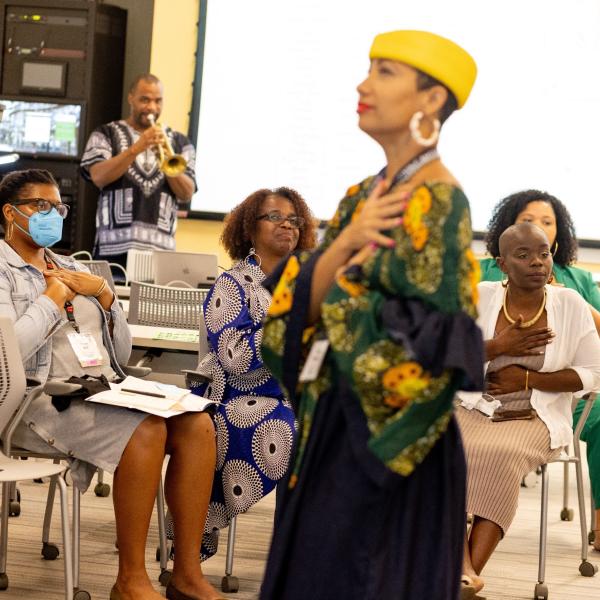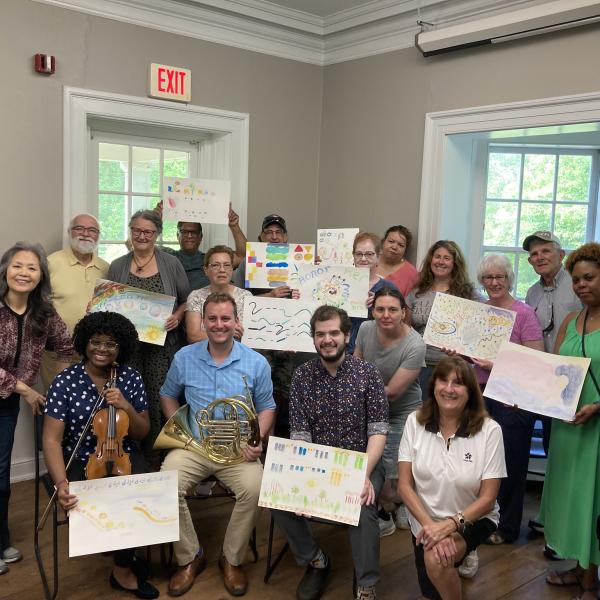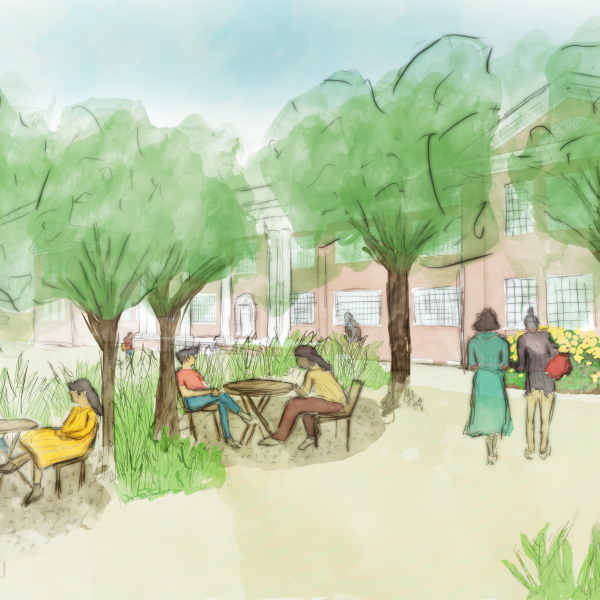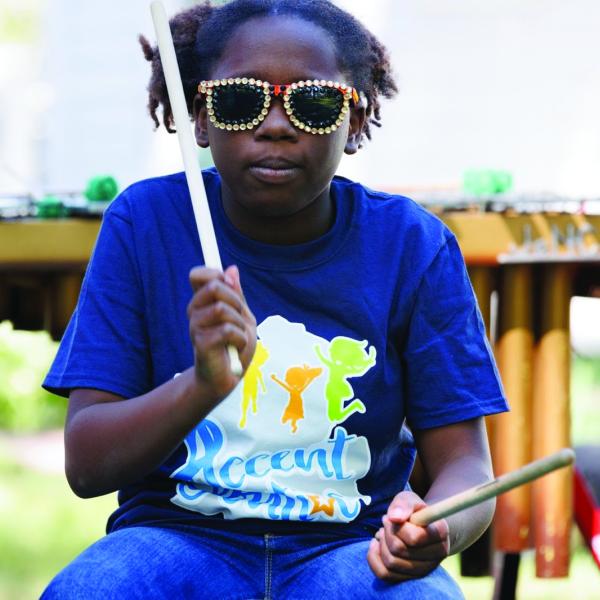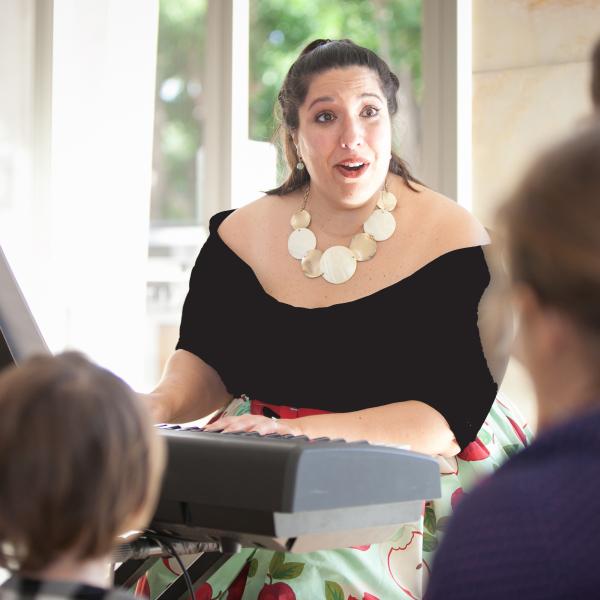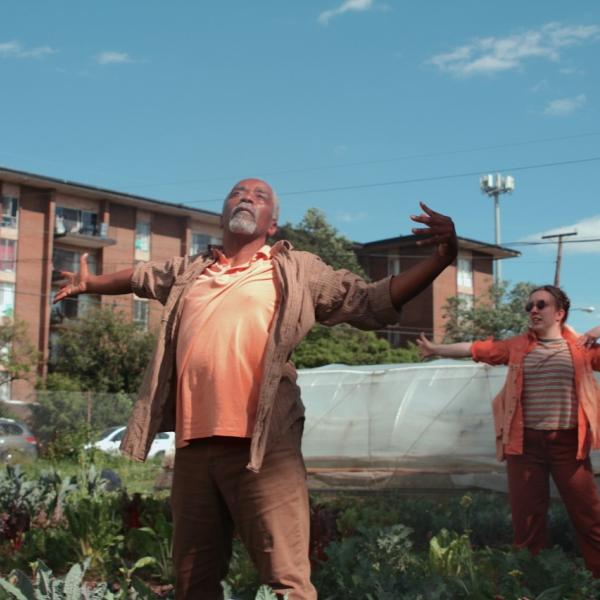From Heritage to Health
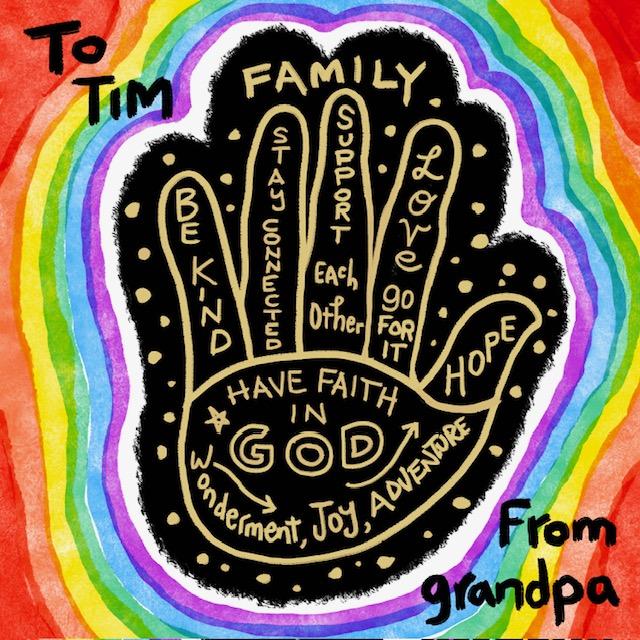
Grandpa's Hand by Soren Glassen, from City Lore's program From Heritage to Health: An Art–Centered Approach to Cultural Competence (H2H). Courtesy of Soren Glassen and City Lore
Folklorist Steve Zeitlin, founder and executive director of City Lore—an organization dedicated to documenting, preserving, and showcasing urban folk culture—joined forces with family nurse practitioner Phyllis Zimmer, founder and president of the Nurse Practitioner Healthcare Foundation to create a multiyear initiative, From Heritage to Health (H2H), a project supported in part by the National Endowment for the Arts. H2H's primary objective is to narrow the gap between healthcare providers and patients. Through diverse art forms and narratives, the project serves as a conduit between conventional Western medical practices and the rich tapestry of people's beliefs and traditions. Additionally, it encourages medical institutions to undertake arts-centered initiatives that offer comfort and care to patients.
We talked with Zeitlin and Zimmer about the creation and impact of H2H and the ways in which the arts contribute to public health and the well-being of communities.
Music Credits: “Greatful World” composed and performed by Loco Lobo. Used courtesy of the Free Music Archive (License: CC BY-NC-SA)
From the National Endowment for the Arts, this is American Artscape online, I’m Josephine Reed.
This issue of the NEA’s magazine American Artscape is looking at the intersection of arts and health; we’ll be exploring ways the arts can contribute to the public health, well-being, and resilience of individuals and communities throughout the country.
Steve Zeitlin: …in Western medicine, the key item is always the pill. In African medicine, the key item is always the story, and we feel like the courses and the toolkit we're doing is really an effort to humanize the way in which medicine is practiced in America these days.
Phyllis Zimmer: We did a survey of potential learners and asked, what do you know about culture aspects of health? What do you know about how you could use the arts as a tool, a therapeutic tool? And what we got back was health care professionals across the board said, “I just don't have the background that I need.”
That was folklorist Steve Zeitlin—he’s the founder and executive director of City Lore the first organization in the country devoted expressly to the documentation, preservation, and presentation of urban folk culture or put another way, the art of everyday life. And then we heard from family nurse practitioner Phyllis Zimmer-- she’s the founder and president of the Nurse Practitioner Healthcare Foundation. City Lore and the Nurse Practitioner Healthcare Foundation have partnered to create a multi-year project called From Heritage to Health (H2H). H2H highlights the ways in which storytelling and the arts can help medical professionals as they treat an ever-more culturally diverse population. It is aimed at bringing healthcare providers closer to patients, by using various art forms and stories as bridges between Western medical practices and people’s beliefs and traditions, and to encourage hospitals and other medical settings to undertake arts initiatives that can both provide comfort and care for patients.
Funded in part by the National Endowment for the Arts, H2H includes a learner needs assessment, public and professional presentations, accredited eLearning courses, and other forms of educational outreach that enhance cultural understanding in healthcare practices and has recently expanded to include an arts-centered approach to issues around death and dying. H2H contains robust toolkits that highlight its central themes and ideas: presenting compelling videos in which artists from different cultural backgrounds offer their perspectives on healthcare, wellness, death, and dying. The program also offers three accredited eLearning courses: Concepts of Culturally Sensitive Care, Welcoming Patients to Your Practice, and Harnessing the Power of the Arts for End-of-Life Care.
I was eager to explore H2H for American Artscape online, so I reached out to Steve Zeitlin and Phyllis Zimmer. We began our conversation with Steve explaining the origin story of From Heritage to Health.
Steve Zeitlin: The National Endowment for the Arts had a special initiative which was a call for arts organizations to collaborate with other disciplines, and I had always wanted to do something bringing the relevance of folklore in the arts to health. I had met Phyllis years ago and I thought, why don't I call my old friend Phyllis and see if she would like to be a joint applicant with City Lore, the Nurse Practitioner Foundation, be a joint applicant for the National Endowment for the Arts and we then collaborated on that project and created a series of programs called From Heritage to Health and they showcase the work of community-based artists and the kind of wisdom they bring that's useful for medical professionals. So that's how it all got started. Phyllis, do you want to add anything to that?
Phyllis Zimmer: What is, to me, one of the most exciting aspects of the programs that we've done to date and that is that we try to blend aspects about cultural aspects of health together with the arts and how the arts bring culture into patient care. These aren't boring didactic courses that people take. These help the learner understand maybe a concept about cultural aspects of health, but through the lens of the artist or the tradition bearer or the folklorist. The feedback that we've had on these courses is that it's a wonderful way to learn some of the concepts about cultural aspects of care, but both in a fun way, but also in a meaningful way, a way that people remember. People respond to the stories. People respond to the visual arts. People respond to music and dance and poetry in ways that they don't to a handout in the classroom. So these programs have really blended the unique aspects of the arts with some very important concepts that we need to have people understand in providing care across diverse populations.
Jo Reed: Steve Zeitlin explained the different components of the initiative, including their target audiences.
Steve Zeitlin: We've done a few different things. Some of them are aimed specifically at medical professionals, and others are aimed at the general public. The eLearning courses are courses that doctors, nurses, pharmacists, receptionists who work in hospitals, hospice workers can take through a continuing education program. So they get credit for continuing education for taking these courses. We've also created a public toolkit for both Heritage to Health and the latest course, which is Harnessing the Power of the Arts for End-of-Life Care. These basically speak to both the public and to medical professionals. So anybody can go on to the toolkit, not only learn how to take the courses, but just hear a lot of the stories that we've gathered. So we're taking things from a lot of different cultures and showing how relevant they can be for a medical practitioner or for somebody who's just interested in making the life of somebody whose life is ending a little bit better.
Jo Reed: Phyllis Zimmer.
Phyllis Zimmer: And in addition, we've also done some public programs. On our first two courses, we partnered with Reimagine End of Life and actually presented materials to the public out in San Francisco, and we're partnering with Reimagine again on our current project to do some public programs and those will be an opportunity for the general public to hear from an artist directly, to hear some of the stories, to be introduced to the toolkit and what's available through the toolkit, and then there'll be some time for some general question and answer or just open discussion. So these programs have had three components each, coursework, toolkit, and public programs.
Jo Reed: From Heritage to Health aims to demonstrate how various art forms and stories can serve as bridges between Western medical practices and various traditions, beliefs, and culture. Steve explained how this might work in practice.
Steve Zeitlin: One of the Native American gentlemen, Keith Bear, that we talked to, pointed out that there are so many people that are considered family. His cousins are his brothers and every family in the Native American tradition is very large and those people want to be in the hospital room. When we're thinking of making rules about who can visit and you're talking about a culture where families are very large and very intimate, it's very hard to say, okay, only two people can visit today. You can't just deny them their family. That's the kind of thing that happened. One of the other Native American women that we talked to pointed out that a lot of times ghosts that people see just before they die, the hospital mistakes for hallucinations, and they're really part of a particular cultural set of beliefs that doctors and nurses really need to know about.
Jo Reed: Phyllis Zimmer added this important aspect of the program: they ask the providers to examine their own beliefs and preconceptions.
Phyllis Zimmer: We do right up front in one of our courses talk about bias and so you have to look within yourself when you're providing care for other individuals. What are your own personal beliefs, traditions? What are your own stories? Do you let other groups in, or are you biased against them in some way? So we do spend a little bit of time in the course really encouraging our learners to understand that bias can really prevent a relationship between the provider and the patient. Bias can really get in the way of providing good care and there is a lot of thinking that needs to go along with that. We believe that people who complete these courses don't just leave it there. We've given them food for thought that they need to mull over over time, and they need to try some of these different suggestions that we've given them and have some success and then use them some more.
Jo Reed: From Heritage to Health started with a toolkit and two accredited courses: Concepts of Culturally Sensitive Care and Welcoming Patients to Your Practice. Steve asked artists across disciplines and cultures for their participation as they put the toolkit and courses together.
Steve Zeitlin: The most exciting thing for me at City Lore is to kind of be able to think through all the many, many artists that we've worked with over the years and see which ones have stories that are particularly relevant for medicine and for teaching about cultural sensitivity. Annie Lanzolato, who's one of the people who we've featured, is a just wonderful storyteller who is also a cancer survivor and has kind of lived through so many different medical treatments since she was diagnosed with terminal cancer 30 or 40 years ago, and has created all of these stories that just really help other people understand how to humanize the medical system, what its faults are, and how it can become more human. Even recently, when I was at the doctor, the doctor was complaining that their job is all clicks. It's all clicks on a computer, and what all three of our courses are trying to do is say that, you know, there's really more to health than clicks. Kaoli Kamara, one of the artists we interviewed, said that in Western medicine, the key item is always the pill. In African medicine, the key item is always the story, and we feel like the courses and the toolkit we're doing is really an effort to humanize the way in which medicine is practiced in America these days.
Jo Reed: But in the United States, health care is largely governed by insurance companies and more and more often by large medical conglomerates. Medical providers are under tremendous pressure to see x amount of patients per day. I wondered how From Heritage to Health takes that pressure into account, how does it try to ameliorate it or even coexist with it? Phyllis Zimmer had these thoughts.
Phyllis Zimmer: I think one of the things that is happening in health care is that there's a strong recognition, certainly in the schools of medicine and nursing and others, that we've let go of some of that important part of health care, which is listening to the patient, and listening as a human being, listening with your heart, not just with your head. And many, many schools have reintegrated courses on humanism and on listening and on caring. Certainly, in nursing, those are key core concepts and we stress those every single day in the classroom and when we place our students in clinical practices. Similarly, in the practice sites themselves, when you talk about the pressure that people feel to see patients: yes, that is true, it is a real problem, but I can also tell you that providers make choices about what to do with that time and there is a way to blend getting the necessary medical information with also listening to what the patient's true concerns are. You don't have to start the interviewing process by saying, “We have 20 minutes, so I can only pay attention to the first two problems on your list.” Instead, you can say, “how can I help you today?” And that opens the door for that patient to say, “well, this is what's important to me today.” The hard part is sometimes the patient will say something that is totally away from what you know, you do need to talk with that person about today, but the art of health care, the art of medicine, if you will, is learning how to bring patients along with you but also have you be walking along with them. It really is a partnership, and I think this kind of course highlights that and it gives people tools to use to show them that there are resources available.
Jo Reed: Steve Zeitlin agrees.
Steve Zeitlin: Our goal is to move people through the stories that these artists are telling, is to move them into bringing that kind of emotion and their own stories into the way they practice medicine. So really a lot of this is about storytelling and the power of storytelling and how the power of storytelling can change the way a doctor or a nurse goes into that and the way they can fight back against the kind of pressures that are on them to be only clicking in a computer and only having five minutes with each patient. So we feel like giving them the kind of emotional inspiration in these courses is a way of getting them to push back against some of the problems in American healthcare.
Jo Reed: Because the growing diversity of the U.S. population makes it challenging for healthcare teams to adequately address the specific needs of each diverse group of patients, stories from different cultures can help providers better understand and therefore treat patients. Phyllis Zimmer explains.
Phyllis Zimmer: People don't have the cultural background that we wish they would have. One of the issues that we faced, we did a survey of potential learners and asked, what do you know about culture aspects of health? What do you know about how you could use the arts as a tool, a therapeutic tool? And what we got back was health care professionals across the board said, I just don't have the background that I need. Our population is becoming so diverse, representing so many different cultural groups, that I feel a little lost when I try to customize the care I provide. So what these courses do is just start opening the doors to say, “Look at yourself. Look at your interactions with patients. Look at how you pose questions. Are you open to answers that are very different from maybe your own framework? Here are some ideas about how you can use the arts as a therapeutic tool to create that bridge with the patient.” Finding a point of something that you can share is really important, and once you find that one thing, it will lead to something else and that will lead to something else and that's how you grow the relationship.
Jo Reed: Phyllis then addressed how From Heritage to Health deals with the important issue of inclusivity.
Phyllis Zimmer: We certainly can't review every single cultural group that exists in this kind of a course. So what we really have tried to do is come up with exemplars and with models. We provide a framework. These are the kinds of things you should be thinking about and then here are several examples of how you might implement that in your practice. One of the things that these courses do is give you an approach. They give you a set of questions that you can ask across the board and then delve in deeper with, what does that mean, or how might you do that in your culture? That you can ask the follow-up questions to get the information to customize the care that you provide. It's really a very unique approach. It certainly doesn't solve all the problems in health care. But it does give the individual clinician a resource to go to, and it gives you a model and it gives you a different way of thinking about the world and I think you need that when you're going to be partnering in care with patients over a period of time. These are relationships that need to be built over time. They don't just happen without some thought and some effort.
Jo Reed: I was curious how long it took to put the toolkits and the courses together.
Phyllis Zimmer: They take a while to put together. I think each of them has taken us about a year of finding the storyline that we want to present, identifying the artists, meeting with the artists, doing all of the interviews, finding the art forms that we want to showcase. There's all the magic of how it all gets put together. Steve has got some filmmaking background, thank goodness. So he's been instrumental and he and his team have just done amazing work.
Jo Reed: While the program can be used by anyone, there is, of course, an emphasis on reaching medical practitioners. Phyllis Zimmer explains their strategies for connecting to those groups.
Phyllis Zimmer: We have multiple avenues of outreach. Certainly, the database for the foundation is one key way and we do email blasts and that sort of thing on a monthly basis to let our potential learners know that the courses are available. There is no charge for the courses. They are free to the learner. But then in addition, we've partnered with a company called MyCME, and they actually host the courses on their learning platform and partnering with them means that you also have access to their very, very robust database of physicians, physician assistants, nurses, nurse practitioners, pharmacists, social workers, the whole array of health care professionals, and so they do a regular marketing program for us over the course of a year. Then in addition, my staff has reached out to state and national health care organizations to let them know that this is available for their members, and it's available at no charge, and we welcome their participation in the project. So we have multiple ways that we've tried to reach out to the health care world to let them know that the courses exist and to let them know about the toolkit.
Jo Reed: And the response from the health care providers has been extremely gratifying.
Phyllis Zimmer: Well, we are really proud of our numbers. We've had over 10,000 learners each for the first two courses. Of course, they've also been out there the longest. But I checked our numbers on our most recent course, and we're over 430 learners on our Harnessing the Power of the Arts at the End-of-Life course and that has only been out there for I think about eight weeks. So people are really responding to these courses. The other CE that I've done through the foundation, we're lucky to get 1,500 learners over the course of a year or two, so these courses have really, really been stellar in terms of how people have responded to them.
Steve Zeitlin: For me, too, what's amazing about the courses, too, is that each one has a test at the end of the course. So, we know that people have finished the course and taken the test and evaluated the program. So it really shows us that people are engaging with this in a really meaningful way, which is very exciting for the arts because we actually have the data to back it up.
Jo Reed: Both Phyllis and Steve agree that creating these programs may have had its challenges but there was real joy in the collaborative process. Phyllis Zimmer.
Phyllis Zimmer: One of the things that I personally found really challenging was blending sort of that more academic piece with a piece that is so creative and so vibrant in the arts. Creating the scripts, I think, was really challenging and all I can say for any of your potential listeners who have an interest in this kind of thing, the way that you collaborate is so important. I often was the person who was doing the draft of the framework of the script, and then Steve would work his magic and weave in that artistic piece and that different way of thinking about something. And I think it was an incredibly challenging process for both of us. But I think both of us are feeling that we've really created a set of programs that are pretty special and that we're so excited that people are really responding to.
Jo Reed: And Steve Zeitlin.
Steve Zeitlin: Collaborating with Phyllis….here we are in two such different fields. But the fact that we've been able to bring these two visions that are so discreet: nursing and that world to folklore and the arts and bring them together and create something that's really a fusion of both. Because what's wonderful about the courses is that these artists are speaking in such an artistic language and Phyllis is putting it in such articulate, medically friendly terms and the jointedness of that, and the ability of the two of us to work together to bring those two fields together has really been an extraordinary experience for me.
Jo Reed: From Heritage to Health has already been successfully expanded to encompass cultural practices and rituals around end-of-life care. Now City Lore and the Nurse Practitioner Healthcare Foundation are thinking about how to extend it even further. Steve Zeitlin hints at what might be next.
Steve Zeitlin: Well, we have been brainstorming about other ideas that we might want to do. One of them is about birth, because there's so much lore and magic surrounding birth. There are birth midwives and death doulas, and a lot of folklore about birth and we've also talked about doing one on dementia, because we know quite a number of people who have worked on poetry and dementia and song and dementia and we feel like these would lend themselves to a heritage to health approach. So, fingers crossed.
Jo Reed: I was speaking with Steve Zeitlin—he’s the founder and executive director of City Lore and Phyllis Zimmer the founder and president of Nurse Practitioner Healthcare Foundation. We were talking about their organizations’ joint initiative From Heritage to Health. You can find more about From Heritage to Health on their websites: https://citylore.org/, just click on special projects under the program tab and the Nurse Practitioner Healthcare Foundation at nphealthcarefoundation.org, click on the education tab. And we’ll have a link on our website as well.
This has been American Artscape online. The music is “Greatful World” composed and performed by Loco Lobo. Used courtesy of the Free Music Archive (License: CC BY-NC-SA)
For the National Endowment for the Arts, I’m Josephine Reed. Thanks for listening.



